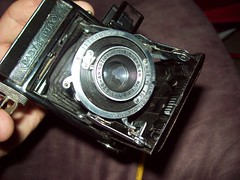Baby Leotax
The Baby Leotax is a Japanese 3×4cm folding camera made before or during the war by Shōwa Kōgaku.
Original documents
Various recent sources say that the Baby Leotax was released in 1941,[1] but no original document has yet been found to confirm this. The Baby Leotax is not mentioned in the official list of set prices compiled in October 1940 and published in January 1941, presumably because it was not yet available.[2] The camera only appears in the government inquiry listing Japanese camera production as of April 1943, as made by Shōwa and distributed by Misuzu Shōkai.[3]
Description
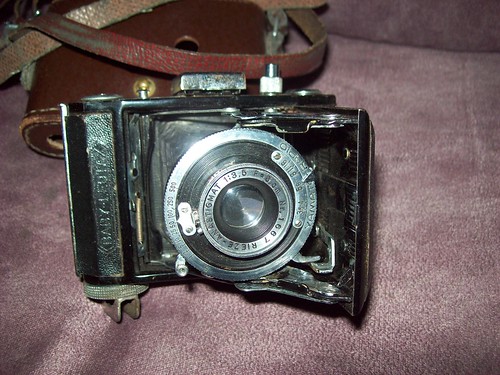
|
| Baby Leotax, Rieze-Anastigmat 5cm f/3.5 lens no.1667, Yamato-Rapid shutter (B, 1–500). Picture by Lincoln Kush. (Image rights) |
The Baby Leotax is a vertical folding camera copied on the Baby Ikonta. (Other Japanese copies of that camera are the Baby Lyra and the folding Baby Germa, which is extremely similar to the Baby Leotax.)
There is a folding optical finder on one side. The body release is on the left of the viewfinder, as seen by the photographer holding the camera horizontally. The advance knob is at the bottom right, and there is a tripod thread at the bottom left. The back is hinged to the left and is locked by a sliding bar on the right. There are two red windows to control the film advance, protected by a common sliding cover.
The name BABY-LEOTAX is embossed in the front leather and there is an S.W.K. logo engraved in the folding struts (presumably for Shōwa Kōgaku).
The shutter is a Yamato Rapid (B, 1–500), engraved YAMATO-RAPID on the speed rim. It was made by Yamato Kōki Seisakusho.[4] The lens is a front-cell focusing Rieze Anastigmat 5cm f/3.5. It has three elements and was made by Fujita Kōgaku Kikai.[5]
Surviving examples
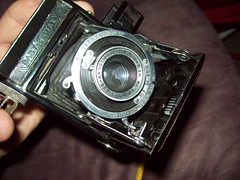  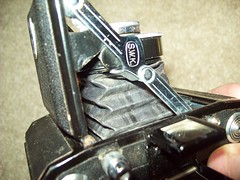
|
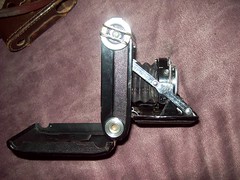 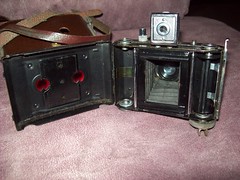 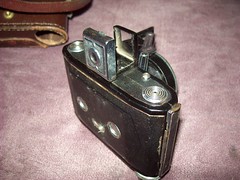
|
| Baby Leotax, Rieze-Anastigmat 5cm f/3.5 lens no.1667, Yamato-Rapid shutter (B, 1–500). (The key soldered to the advance knob is surely not original.) Pictures by Lincoln Kush. (Image rights) |
The Baby Leotax was certainly produced in limited numbers, and only a few surviving examples are known. The early cameras have a black lens bezel with the lens name in lowercase letters.[6] Later ones have a silver lens bezel with the lens name in capital letters.[7]
Notes
- ↑ Date: Omoide no supuringu-kamera-ten, p.26; McKeown, p.891; Sugiyama, item 1158.
- ↑ "Kokusan shashinki no kōtei kakaku".
- ↑ "Kokusan shashinki no genjōchōsa" ("Inquiry into Japanese cameras"), item 166.
- ↑ "Kokusan shashinki no genjōchōsa" ("Inquiry into Japanese cameras"), shutter item 18-R-10.
- ↑ "Kokusan shashinki no genjōchōsa" ("Inquiry into Japanese cameras"), lens item Jb6.
- ↑ Example pictured in Sugiyama, item 1158, and in McKeown, p.891 (this is perhaps the same camera, with lens no.14xx).
- ↑ Examples pictured in this article (lens no.1667), in Fujishima, p.23 of Kurashikku Kamera Senka no.8 (lens no.1737), and in Omoide no supuringu-kamera-ten, p.26 (lens no.1856).
Bibliography
- Fujishima Kōichi (藤島広一). "Shattā ni yoru nendai shibetsu" (シャッターによる年代識別, Dating a camera from its shutter). Kamera Rebyū: Kurashikku Kamera Senka (カメラレビュー クラシックカメラ専科) / Camera Review: All about Historical Cameras no.8, September 1986. No ISBN number. Supuringu kamera (スプリングカメラ, special issue on spring cameras). Pp.21–4.
- "Kokusan shashinki no kōtei kakaku" (国産写真機の公定価格, Set prices of the Japanese cameras), listing Japanese camera production as of October 25, 1940 and setting the retail prices from December 10, 1940. Published in Asahi Camera January 1941 and reproduced in Shōwa 10—40nen kōkoku ni miru kokusan kamera no rekishi (昭和10〜40年広告にみる国産カメラの歴史, Japanese camera history as seen in advertisements, 1935—1965). Tokyo: Asahi Shinbunsha, 1994. ISBN 4-02-330312-7. Pp.108—9. The Baby Leotax does not appear in that document.
- "Kokusan shashinki no genjōchōsa" (国産写真機ノ現状調査, Inquiry into Japanese cameras), listing Japanese camera production as of April 1943. Reproduced in Supuringu kamera de ikou: Zen 69 kishu no shōkai to tsukaikata (スプリングカメラでいこう: 全69機種の紹介と使い方, Let's try spring cameras: Presentation and use of 69 machines). Tokyo: Shashinkogyo Syuppan-sha, 2004. ISBN 4-87956-072-3. Pp.180–7. Item 166.
- McKeown, James M. and Joan C. McKeown's Price Guide to Antique and Classic Cameras, 12th Edition, 2005-2006. USA, Centennial Photo Service, 2004. ISBN 0-931838-40-1 (hardcover). ISBN 0-931838-41-X (softcover). P.891.
- Omoide no supuringu-kamera-ten (思い出のスプリングカメラ展, Exhibition of beloved self-erecting cameras). Tokyo: JCII Camera Museum, 1992. (Exhibition catalogue, no ISBN number.) P.26.
- Sugiyama, Kōichi (杉山浩一); Naoi, Hiroaki (直井浩明); Bullock, John R. The Collector's Guide to Japanese Cameras. 国産カメラ図鑑 (Kokusan kamera zukan). Tokyo: Asahi Sonorama, 1985. ISBN 4-257-03187-5. Item 1158.
The Baby Leotax does not appear in Kokusan kamera no rekishi.
